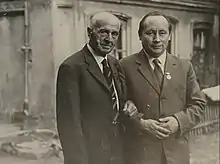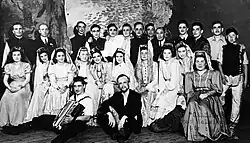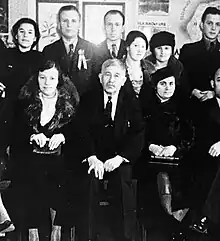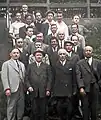Aisa Hakimcan
Ğaysə Xəkimcan (Гайсә Хәкимҗан,[1] for Finnish Tatars: Aisa Hakimcan [hakim'd͡ʒan], also spelled as Aisja Hakimsanoff / Hakimsan; from Russian Айся Хакимжанов, Aisya Khakimzhanov; 13 March 1896 – 5 November 1972) was a Tatar artist, publisher and leader, who contributed among the Tatar community of Tampere. He was known as a nationalistic cultural figure, who for example directed plays and wrote poetry. Hakimcan was originally from Russia, Nizhny Novgorod Oblast. His son Räshid was a hockey player and referee.
Ğaysə Xəkimcan Айся Хакимжанов Aisya Khakimzhanov | |
|---|---|
 Ğaysə Xəkimcan and composer Röstəm Yəxin in Kazan. (June 1970). | |
| Born | 13 March 1896 |
| Died | 5 November 1972 (aged 76) |
| Resting place | Kalevankangas Cemetery |
| Other names |
|
| Organizations | |
| Children | Aliye, Räshid |
| Parent(s) | Khakimzhan, Maryam |
| Signature | |
 | |
Biography
Born as the son of Khakimzhan and Maryam in the Nizhny Novgorod Governorate Mishar village Aktuk, Aisa Hakimcan (Khakimzhanov) came to Finland in 1917.[2][3] Like most other Tatars of his generation, Hakimcan made a living as a merchant, but among the Tatar community of Tampere, he was best known as a tough leader and a versatile artist.[2][4]

Hakimcan was involved in the founding of local Islamic congregation, and later worked at the board. Slightly before this, a short lived predecessor to given congregation was founded and Hakimcan was in a leading position of the project. Hakimcan was also the chairman of The Tampere Turkish Society in late 1940s, and vice chairman multiple times.[2][5] At the turn of the 1920s, Hakimcan had been one of the Muslims in Tampere, who signed a letter to the imam of Helsinki, urging him to initiate the project of establishing a Tatar congregation.[6]
Among the community Hakimcan was known as a very musical person. He sang, played violin, mandolin and operated as a choir director. Hakimcan also wrote poetry and directed plays named Aliyebanu (Ğaliyəbanu) and Asılyar, both by Mirkhaydar Fayzi[7]. He also acted himself; for example in 1930s, when a play Zöleyha (Zöləyxa) was shown at Tampere Theatre, in honor of guest Ayaz İshaki, who is said to have been very pleased with the performance and "appropriately chosen" actors[8]. (Hakimcan was one of the leads and Turkestan-born Gibadulla Murtasin was the director.[9]) Aliye, the daughter of Aisa, as well as the children of his brother; Zinnetulla, Semiulla, Hamdurrahman and Hafize, all took part in his plays. They were known as a talented family among the Tatars.[10]
The voice of Hakimcan has been described as being very melodic and it was suitable not only for singing, but also for giving Tarawih prayers during Ramadan, which he recited at his congregation for decades.[2][9]
His poetry dealt usually with the feelings of longing for his birthplace and in general with his people. In short, he expressed his feelings in the opening page of one of his publications, Kisäk millī ši`ïr vä ğïrlar (1956-1966), as follows:
Belməsəm il dərtləren, min bolay yazmas idem. Millətemne söyməsəm, kulıma kələm almas idem - Translation: "If i did not know the sufferings of my people, i would not express my feelings in writing. I would not take a pen in my hand, if i did not love my people.
(Originally written in Arabic script).
The publication consisted of works of the community, collected by Hakimcan.[2][4]
Hakimcan printed and published many songs and poems with his close friend, imam Habiburrahman Shakir. In 1960s they published a booklet in honor of poet Ğabdulla Tuqay. With businessman Semiulla Wafin, he published a work on Islam called Islām dīne ḥaqq dīnder.[2][4][11]

In 1938, a 20-year memorial service for Idel Ural State was held in Warsaw, organized by Tatar activist Ayaz Ishaki. Hakimcan was one of the seven Finnish Tatars who took part in the celebration. Led by the Polish Tatar imam Ali Woronovicz, they visited the tomb of the unknown soldier to honor the deceased fellow Muslims.[12] In June 1970, Hakimcan was invited to Kazan, Russia, by Finnish Tatar cultural figure Ymär Daher. There they went to the "G. Ibragimov Institute of Language, Literature and Art of the Tatarstan Academy of Sciences", where they were greeted officially. Folklorist Ilbaris Nadirov, who had lectured previously at Tampere, was also present. During the trip, Hakimcan paid a visit to poet Tuqay's grave to show his respects.[13][2][14]
In his 1993 publication Çit illərdəge tatar ədəbiyətı həm matbugatı, Kazan Tatar literary scientist Xatıyp Miñnegulov, who has studied Tatar writers abroad mentioned a few Finnish Tatars; Xəsən Xəmidulla, Sadri Xəmit, Gəwhər Tuğanay, and also Ğaysə Xəkimcan.[1][15]
Versions of name
Aisja Hakimsanoff / Hakimsan, Aisa Hakimcan.
- The surname in Russian is usually either Khakimzyanov (Хакимзянов) or Khakimdzhanov (Хакимджанов), but for Nizhny Novgorod Tatars it is Khakimzhanov (Хакимжанов).
- Tatar: Гайсә Хәкимҗанов; Ğaysä Xäkimcanov / Ğaysə Xəkimcanov. (In Mishar Dialect ğ is not pronounced and letter c is affricate d͡ʒ).
Given name comes from the Arabic ʿĪsā, which means ”Jesus”. Surname is derived from Arabic ḥakīm (’wise’) and Persian jân (’soul’).
Surname suffix -ov also stands for a patronymic.
Personal life
Aisa Hakimcan was married to a Finnish woman from Nokia, named Sylvia (1904-1965). She converted to Islam and was actively involved among the Tatar community with her husband. They had two children; daughter Aliye (Aliyä) who was a talented singer and actress in Tatar language and a son, hockey player-referee Räshid (Räşit).[25][26]
The older brothers of Aisa, Ibrahim and Siddik, as well as his mother, widow of a farmer, Merjam Alautdinoff (Maryam Alyautdinova, Märyäm Ğaläwetdinova; 1863-1947) also lived in Finland.[27][28]
Gallery
 Aisya Khakimzhanov. (Tampere, 1920s).
Aisya Khakimzhanov. (Tampere, 1920s). Aisa at the grave of Ğabdulla Tuqay. (Kazan, 1970).
Aisa at the grave of Ğabdulla Tuqay. (Kazan, 1970). Hakimcan (left) in Warsaw, Poland (1938).
Hakimcan (left) in Warsaw, Poland (1938). Meryam Alautdin, mother of Aisa. (1800s).
Meryam Alautdin, mother of Aisa. (1800s). Aliye Aisa kızı. (1922–2013).
Aliye Aisa kızı. (1922–2013). Aisa with his son Räshid.
Aisa with his son Räshid. Relatives in Moscow. (1967).
Relatives in Moscow. (1967). A. İshaki's Zöleyha (Zöləyxa), performed by Tampere Tatars in January 1932. Aisa Hakimcan middle row first from right.
A. İshaki's Zöleyha (Zöləyxa), performed by Tampere Tatars in January 1932. Aisa Hakimcan middle row first from right. Aisa in his costume for Tatar play Aliyebanu; guest Musa Bigi sitting next to him. (Tampere, 1934).
Aisa in his costume for Tatar play Aliyebanu; guest Musa Bigi sitting next to him. (Tampere, 1934). Aisa with his spouse at the celebration for 10-year anniversary of Turkey.
Aisa with his spouse at the celebration for 10-year anniversary of Turkey. Hakimzhan (center) in Kazan, 1970.
Hakimzhan (center) in Kazan, 1970. Tatars in Tampere (1930s). Hakimzhan in backrow, third from right.
Tatars in Tampere (1930s). Hakimzhan in backrow, third from right.
External links
- Wikipedia commons - pictures of A.H.
- Meryam, mother of Aisa Hakimcan in Renat Bekkin’s 2020 article; Connections between Tatars in Petrograd-Leningrad and Finland during the 1920s and 1930s
- A video of browsing Tatar language paper in Russia in 2020 - Includes an image of a play by Ishaki, where Hakimcan played a leading role (0:25)
References
- З.Г. Гарипова: Мөһаҗирлектәге татарларның милли-мәдәни тормышы
- Baibulat, Muazzez (2004). The Tampere Islamic Congregation: the Roots and History (in finnish, tatar and english). Jyväskylä: Gummerus Kirjapaino Oy. p. 146. ISBN 952-91-6753-9.
- Leitzinger, Antero (1996). Mishäärit - Suomen vanha islamilainen yhteisö. Helsinki: Kirja-Leitzinger. p. 45. ISBN 952-9752-08-3.
- Halen, Harry (1996). Lahjan Hedelmät (in a book: Tugan Tel - Kirjoituksia Suomen Tataareista, reporter: Kadriye Bedretdin, 2011). Helsinki: Suomen Itämainen Seura. p. 341. ISBN 978-951-9380-78-0.
- Leitzinger 1996, p. 218
- Suikkanen, Mikko. "Yksityinen Susi - Zinetullah Ahsen Bören (1886-1945) eletty ja koettu elämä".
- "Файзи (Файзуллин) Мирхайдар Мустафович".
- Baibulat 2004, pp. 190, 192.
- Baibulat 2004, p. 190, 192.
- Baibulat 2004, pp. 183-184
- "Abdulla Tukay | Kansalliskirjasto". Finna.fi.
- Baibulat, Muazzez (2004). The Tampere Islamic Congregation: the roots and history. Jyväskylä: Gummerus Kirjapaino Oy. p. 114. ISBN 952-91-6753-9.
- Minnullin K.M., O.R. Khisamov & M.I. Ibragimov (eds) 2019. Institut yazyka, literatury i isskustva imeni G. Ibragimova [The Ġ. Ibrahimov Institute of Language, Literature and the Arts]. Kazan: Institut yazyka, literatury i isskustva imeni G. Ibragimova.
- Baibulat 2004, p. 158
- Миңнегулов Х. Чит илләрдәге татар әдәбияты һәм матбугаты. Казан утлары, 1993, №7.
- Halen, Harry (1996). Lahjan hedelmät (in a book called Tugan Tel: Kirjoituksia Suomen Tataareista, reporter: Kadriye Bedretdin, 2011). Suomen Itämainen Seura. p. 346. ISBN 978-951-9380-78-0.
- "01.12.1935 Tampereen osoitekalenteri No. 1936".
- "ТАТАР ИР-АТ ИСЕМНӘРЕ (ТАТАРСКИЕ МУЖСКИЕ ИМЕНА В АЛФАВИТНОМ ПОРЯДКЕ)".
- Kamal, Kärim (2006). "Könbatış xristiannarı Pasxanı bilgeli, yaña Papa üzeneñ berençe "Urbi et Orbi" yullamasın yasadı".
- Jazyki Rossijskoi Federatsii i sosednih gosudarstv. Tom 3, s. 67–68. Moskva: Nauka, 2005. ISBN 5-02-011237-2.
- Leitzinger p. 45 (1996)
- "TATAR: Table of Correspondences, Cyrillic - Roman" (PDF). Archived from the original on 2014-11-23. Retrieved 2022-12-13.
{{cite web}}: CS1 maint: bot: original URL status unknown (link) - "Хакимзян".
- "Revizskaya skazka 1858 Aktukovo".
- Baibulat, Muazzez (2004). The Tampere Islamic Congregation: the Roots and History (in finnish, tatar and english). Jyväskylä: Gummerus Kirjapaino Oy. pp. 179 & 254. ISBN 952-91-6753-9.
- Baibulat 2004, p. 66, 197, 207
- Leitzinger 1996, p. 131, Baibulat 2004, p. 66
- Tampereen Evankelis-Luterilaisten Seurakuntain Kirkkohallintokunta - Hautakirja 1947, Merjam Alautdinoff, maanviljelijän leski. (Grave record)